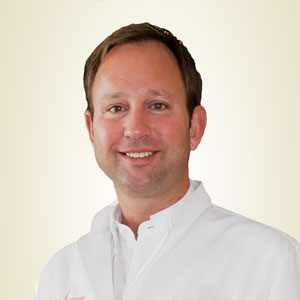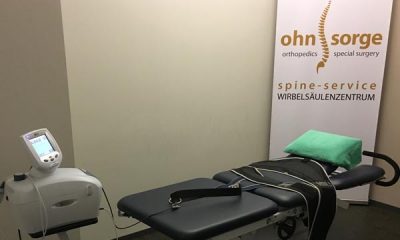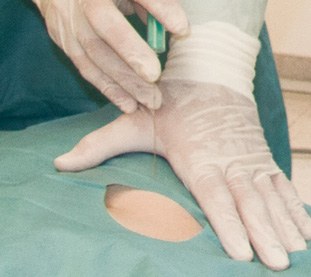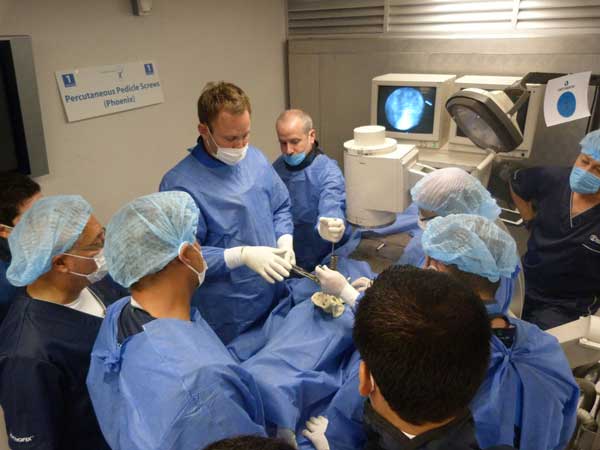orthopedic spine center in Hamburg-Eppendorf
Dear Patient, Dear Visitor,
at ohnsorge spine service you will find excellent medical services fully performed in english. Professor Ohnsorge has formative professional experience from working in the U.S.A. at the Hospital of Special Surgery/Cornell University in New York City and in the UK at the Whittington Hospital/University of London.
As a specialist in orthopedics and trauma surgery, I am an expert in the musculoskeletal system and its central component – the spine. Not patent solutions but honest individual advice is my service. You can expect attentive listening, thorough examination, precise diagnostics and personal counseling, just as a targeted therapy.
ohnsorge spine service, the orthopedic spine center in Hamburg-Eppendorf, offers ideal spatial, technical and personal conditions for conservative and surgical treatment of acute and chronic back problems.
This website should give you a first impression of my professional competence and my way of thinking. Basically, ohnsorge spine service always focuses on conservative treatment with different methods and approaches. Most of these are offered on site in the center.
In some cases targeted interventional pain therapy can also help to heal and relieve discomfort. Sometimes, for a specific medical indication, I recommend a surgical procedure. Modern spine surgery involves innovative and minimally invasive methods that allow for truly gentle surgery. Surgery should always be part of a comprehensive orthopedic treatment plan. Conservative methods are of fundamental importance before and after surgery.
Diagnosis, solutions, treatment and alternative options should always be discussed in person after a thorough consultation and examination. I am more than happy to offer my expertise and help, throughout in English, as well as German, French and Spanish.
Please do not hesitate to contact us via email or by phone to make an appointment.
Until then:
Mind your back!
With kind regards


Prof.** PD* Dr. Jörg Ohnsorge
Ohnsorge stands for modern orthopedics, multimodal therapy and innovative spine surgery. He is a nationally and internationally networked expert for the differentiated surgical and conservative treatment of back disorders of all kinds. As a physician he pursues the concept of individual treatment, precise diagnostics and specific therapy. Ohnsorge is clinically and scientifically committed to minimally invasive surgery.
He received extensive training as a physician, orthopedist and surgeon from well-known teachers such as Prof. Niethard and Prof. Schumpelick at the University Hospital in Aachen, Prof. Laskin at the Hospital for Special Surgery in New York and FLA Dr. Gritze at the Central Army Hospital in Koblenz.
As Deputy Director of the University Department of Orthopedic Surgery in Aachen Ohnsorge also headed the Spine Surgery Section for more than 6 years.
Following this, he served as surgeon-in-chief, chairman and medical director managing large departments of orthopedics and spine surgery.
As an instructor and trainer, Ohnsorge is involved in teaching special minimally invasive spine surgery techniques. In addition to extensive lectures and teaching at the universities of the twin cities of Aachen and Ningbo, he works as an author and reviewer for several medical journals. He also was on the board of various medical societies for many years.
Certification
- Specialist in Orthopedics & Traumatology
- Specialist in Orthopaedics
- Special orthopedic surgery
- Pediatric Orthopedics
- Physical therapy
- Sports medicine
- Chiropractic
- Radiologic skeletal diagnostics
- Specialization Radiation Protection
- Expertise rescue service / emergency medicine
- Advanced Trauma Life Support® / ATLS® Provider
- DEGUM Certificates Sonography Musculoskeletal System
- DWG spine surgeon certificate
- DWG-master spine surgeon certificate


Consultation
My patients benefit from well-founded expertise. It’s the result of many years of specialization in the field of orthopedics and spine surgery. This includes a lively interdisciplinary collegial exchange and research work. Key elements are international contacts, many years of experience and work in various medical societies as well as universities in Germany and China.
ohnsorge spine service starts with modern and detailed diagnostics of spinal diseases. In addition to the medical history and manual examination, high-resolution imaging techniques such as magnetic resonance imaging (MRI) and computed tomography (CT) are of great importance. Infiltrations that are precisely located at presumed sites of pain are another component of a careful and systematic indication. An individual therapy especially tailored to the patient and his specific complaints is the goal.
ohnsorge spine service is characterized by the basic principle of the least interference with the integrity of the human body. That’s why every therapeutic approach is initially conservative. The diagnostic and therapeutic staging scheme implies gentle treatments starting with pure manual medicine, physiotherapy and physical therapy including thermo-schock and laser-techniques. Percutaneous interventions, endoscopic and microsurgical interventions are preferred to major surgeries that however are performed minimally invasively if possible. The latest technology, special instruments, innovative implants and state-of-the-art procedures now enable optimal and individually tailored treatment.
ohnsorge spine service also means close partnership between doctor and patient. The person shall feel safe and well, take confidence, understands his suffering and finally defeat it. The doctor shall be the one to help with words and deeds, with heart and hand.

Conservative therapy
Scientific studies prove what we already knew: An unstable spine hurts. Chronic back pain is directly related to weak muscles. Strong muscles stabilize the spine. By specifically strengthening weak muscles, back pain can be significantly reduced.
The small delicate muscles directly steering the facet joints are naturally weaker than the well-visible outer muscle packages which are mainly responsible for the force. These thin muscles start and control the direction of a movement. Muscle shaping by uniform movement neglects the starter muscles. Even, and especially, in very active athletes a muscular deficit and thus a muscular dysbalance may occur.
If a muscle is overstrained, in the long term, it cramps. Of course, this happens to weak muscles rather than well-trained muscles. A cramp not only hurts. But as it blocks a vertebral joint it leads to functional disorders of the spine. These blocked joints hurt with every movement, as the cramped muscles are painfully stretched.
Shortening of ligaments and tendons is also a consequence of false or missing stress. For similar reasons, these may cause pain. It is therefore only logical that back pain can often not only be improved by conservative measures, but can be treated causally.
The irritated anatomical structure that is primarily responsible for the development of a pain is called a pain generator. Degenerative changes of the facet joints and of the intervertebral discs are common examples.
Stimulating the body’s own (physiological) healing mechanisms is what most forms of conservative treatment do, such as:
- manual medicine
- medical strengthening and training therapy
- 3C distraction therapy
- trigger point acupressure / extracorporeal shockwave therapy
- kinesio-taping
- autologous blood treatment
- regenerative medicine


Interventional pain therapy
If a locally effective narcotic (local anesthetic) is injected at the presumed origin of the pain, the function of the fine nerve endings located there is temporarily suspended. The actual disappearance of symptoms hereafter serves as a diagnostic evidence – proving that the correct pain generator has been identified.
The complete relief from pain usually only lasts for the duration of the effectiveness of the drug. However, the level of pain usually stays lower than it was. Moreover the aim of the therapy is identified. Repetition of the same injection, possibly in addition of other drugs, often leads to a long-term success: sensitivity for pain stimuli is reduced and a causal inflammation calms down.
If this is not enough, the nerve fibers can be destroyed by a laser, by radiofrequency, heat or ice with a special catheter. Since nerves can basically recover and form completely new, it may be that the treatment must be repeated after some time. Thew combination with a minimally invasive surgical procedure may ensure the result for long.
- injections to the joint infiltration / nerve ablation (injection / catheter)
- injections to the iliosacral joint
- periradicular therapy, PRT (injection to the nerve)
- peridural therapy, PDT (injection into the spinal canal)
- discography (intervertebral disc injection)
- Spine IDET / Acutherm (Disc Catheter) / Laser


Spinal surgery
In modern spinal surgery, this is often possible today with so-called minimally invasive methods and procedures.
The smallest intervention in the human body, i. e. the intervention of least invasiveness, is certainly the puncture with a needle. It is effected percutaneously through the skin (see interventional pain therapy). Principally, no other procedure can be said to be minimally invasive, since the tissue injury will always be greater with any other instrument.
In this respect, it is important to understand that minimal invasive surgery is a principle of proportionality. This means that the nature and extent of the minimum access route are defined by the necessary surgical procedure, not vice versa. Using the right technology and special instruments, even a highly complex surgical procedure can be carried out much more gently than in the classic open procedure. Minimal invasiveness is therefore always relative to the result, but must not be sufficient as an end in itself!
Above all, it must not compromise on care and quality, and thus lead to worse results. Minimal invasiveness should never stand alone!
At ohnsorge spine service all surgical procedures are carried out in a reasonable minimally invasive manner using microscopes and micro-instruments. But that does not mean that a small skin incision is of utmost importance. The aesthetic advantages are evident. Much more important is the gentle treatment of all soft tissues including the skin. It should not be overstretched, for it would not heal well. Special attention is to be given at the protection of the muscles. If possible, these should not be detached, cut and destroyed, but dully split in the fiber flow and gently stretched. Uncomplicated fast healing without major scars and rapid recovery is the aim. Only intact muscles can be successfully practiced after an operation.
- Vertebral augmentation (treatment of a vertebral body fracture)
- decompression
- nucleotomy / sequestrectomy (treatment of a herniated disc)
- endoscopy
- Microsurgery
- Interspinous spacers
- Dynamic spinal fusion
- spinal fusion
- percutaneous spondylodesis
- intervertebral disc prosthesis
- 360 ° fusion
- reconstruction
- revision



